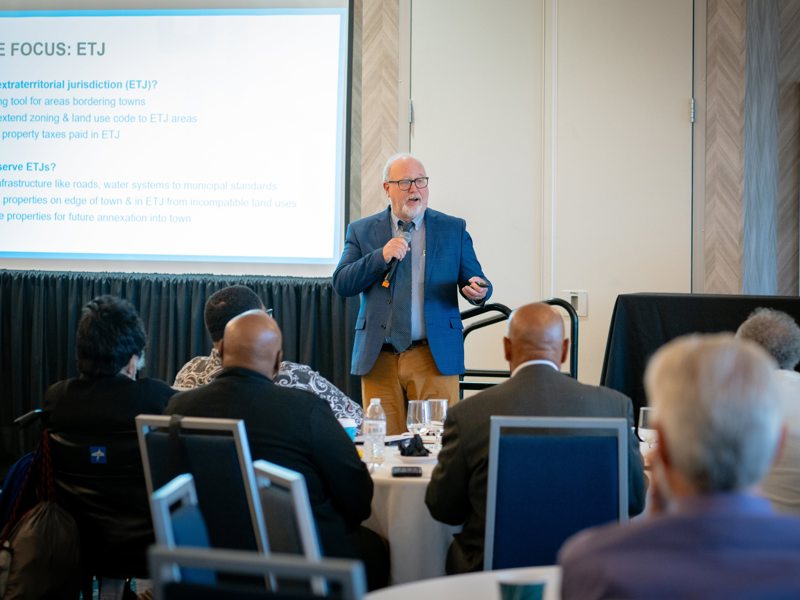Why Extraterritorial Jurisdiction Still Matters
Q1 2025 | Vol. 75, Issue 1
More than a century ago, the North Carolina General Assembly granted the City of Greensboro the authority to impose sanitary regulations up to a mile beyond the city limits. That grant of authority came as Greensboro considered, and then adopted, a ban on keeping hogs in the city and within a quarter mile of the city limits.
And so, the use of extraterritorial jurisdiction (ETJ) by cities to prevent incompatible uses within North Carolina began.
Roughly 115 years later, cities and towns across North Carolina and across the country continue to use extraterritorial jurisdiction to protect property owners living along their peripheries from uses that could damage or devalue their property.
Since that time, the uses of ETJ as a land-use planning tool have become more varied even as many areas are much less likely to see a hog site suddenly pop up near their home. But more recently, and as involuntary annexation has been effectively prohibited in North Carolina, some legislators have challenged its use in some localities and even statewide through proposed legislation. Some of those bills have become law, while others have failed to pass.
ETJ HISTORY
After that initial grant of ETJ authority to Greensboro in 1912, the same powers were extended to Raleigh, Gastonia, Tarboro and Chapel Hill in the years after World War II. During that same period, ETJ was growing in use across the country as the United States experienced a post-war housing boom and as residential growth increasingly clashed with land uses that were not amenable to the building of suburban neighborhoods. In fact, home builders and developers were some of the biggest early supporters of ETJ. Then, in 1958, the NC General Assembly created the Municipal Government Study Commission to examine the issue. The commission concluded:
Health and safety problems arising outside the city do not always respect city limits as they spread … Subdividers of land outside the city commonly wish to tie into city water and sewerage systems. New industrial and commercial development may, for a variety of reasons, take place just outside the corporate limits. Visitors to the city receive their first impression from these outlying areas.
The commission recommended that ETJ authority be extended to all municipalities with a population of 2,500 or more, and since then legislation has extended that power to cities and towns across the state.
Still, there have been tensions regarding ETJ, both historically and more recently, at the General Assembly. The ability to extend land-use rules beyond a city boundary has often led to cries of, “Regulation without representation.” That criticism has come even though ETJ residents are represented on local planning boards and boards of adjustment.
Over the last decade or so, the General Assembly has eliminated ETJ in Boone, Weaverville, Maggie Valley and Asheville through the approval of local bills. This past year, Southport was the latest municipality to lose its ETJ, while Kings Mountain had its authority restricted. In most of those cases, a local dispute over land use led to the filing of the legislation.
But legislation was also filed in 2023 that would have eliminated or limited ETJ statewide, depending on the size of the municipality. In 2024, a proposal was defeated that would have eliminated ETJ in all Moore County municipalities.
Besides the local disputes, often the rationale behind the efforts to limit or restrict ETJ authority has been that, without involuntary annexation power, cities no longer needed ETJ to plan for future incorporation. That narrative ignores that cities continue to voluntarily annex areas, particularly subdivisions where developers want and need the water and sewer services provided by city governments, not to mention services including road maintenance, street lighting and public safety.
But there are other important reasons to preserve extraterritorial jurisdiction.
ETJ, ORDERLY GROWTH AND STRONG LOCAL ECONOMIES
Cities utilize a combination of extraterritorial jurisdiction, land-use planning, and control and extension of water and sewer utilities to promote orderly growth. This is especially important in North Carolina’s growing suburban communities. It is also crucial in tourism communities that need to ensure that areas adjacent to their town remain attractive so that visitors continue to come and allow their local economies to thrive.
It is important to note that at least 14 counties in North Carolina have no zoning and at least that many more offer zoning only in portions of their county.
For growing towns and cities, careful planning may mean the difference between having the utility capacity and taxpayer-supported resources to bring a major employer to an area, or not. Orderly growth also allows for the amenities and aesthetic appeal that make an area attractive to businesses in the first place. Allowing residential or commercial growth with little or no local government land-use planning invites haphazard use of taxpayer resources for infrastructure, local citizen pushback and anti-growth sentiment, as well as poor standards that damage long-term economic growth.
The notion that poor land-use planning and a lack of orderly growth can damage the economic prospects of a city or larger metropolitan area is not theoretical. It is exactly what has occurred in some Northeastern and Upper Midwest cities.
In addition, several municipalities across North Carolina entered into interlocal agreements, carefully negotiated and planned among each other and the county government, to set their ETJs. These agreements allow each to anticipate service needs for the future. Some of these have been memorialized in local legislative acts.
Finally, the use of extraterritorial jurisdiction is often specific to individual cities and towns and the individual circumstances faced by each.
Here are a few examples of those individual uses:
HAVELOCK USES ETJ TO PROTECT MARINE AIR BASE
Nearly a decade ago, Havelock extended its extraterritorial jurisdiction to the west and southern parts of the town, a move that had nothing to do with any plans for future annexation. Instead, the extension of ETJ was all about protecting Marine Corps Air Station Cherry Point from development that might infringe on its mission and operations of the air station. The ETJ extension was the result of an extensive planning process that involved town officials, county officials and base leaders, culminating with the 2016 Cherry Point Land Use Study.
At the time, everyone involved agreed: “The true driving force behind this is the protection of Cherry Point.” While local government officials may have sought other means to accomplish that protection, putting the area under the thorough planning ordinances of the town was seen as the most efficient way to do so. It was accomplished with little controversy.
ETJ AND SPHERE OF INFLUENCE AGREEMENTS IN MECKLENBURG
For more than 40 years, municipalities in Mecklenburg and Cabarrus counties have been using a combination of extraterritorial jurisdiction, local legislative acts and cooperative “sphere of influence” agreements to chart out how growth will take place in these communities. Local legislation was first approved in 1983 establishing the authority for the City of Charlotte to enter into sphere of influence agreements with other Mecklenburg County towns so that each municipality could plan out how it would accommodate growth in the future, and extend ETJ into those areas without fights among each other regarding whose development rules would apply.
Today, with additional local legislation approved in the 1990s and early 2000s, these cooperative agreements extend beyond Mecklenburg County to include Kannapolis and Concord. The result is planning for growth that is typically less contentious than in fast-growing areas without these agreements. The extension of land-use planning allowed through ETJ is a key aspect of this approach to growth.
HARD CHOICES IN BRUNSWICK COUNTY
Brunswick County has been among the fastest-growing areas of North Carolina this decade, so it should come as no surprise that the use of extraterritorial jurisdiction as a planning tool has come under scrutiny. In 2024, over the objections of the Town of Southport, the General Assembly eliminated the town’s ETJ. Other municipalities in the county, meanwhile, became alarmed over talk of the elimination of ETJ across the county.
As in other parts of the state, those concerns center on both factors unique to the communities and the longstanding use of ETJ as a protector against incompatible uses that can damage adjoining property values. In Southport, municipal officials worry particularly about incompatible development in the corridors leading into their town. Some ETJ residents fear that higher-density development under county zoning rules will lead to more traffic and negatively affect their quality of life.
Other municipalities in the county, if the ETJ ban were extended to them, look at the possibility of negative effects on fire protection. In Shallotte, town firefighters provide protection for a fire district that extends into the ETJ and beyond. The fire department receives about $1.1 million from fire fees accessed across the district; the remaining portion of its $2 million fire budget comes from municipal taxpayers. Keeping ETJ density and structure planning rules in place ensures that the town isn’t faced with a hard choice between spending more on fire service or seeing residents’ homeowners’ insurance rates rise.
It is difficult to predict whether more legislation will come about challenging ETJ authority in the future. But to ensure that the authority is preserved in the places where it is particularly important will require continuing conversations with state policymakers and continuing communication about why it should matter to residents.







